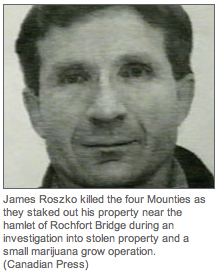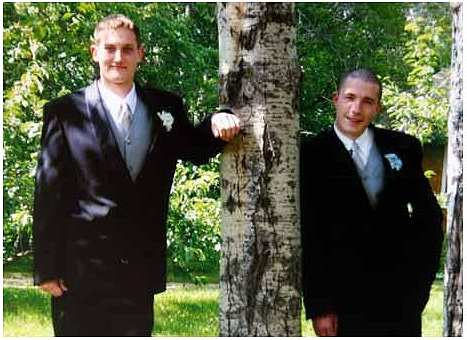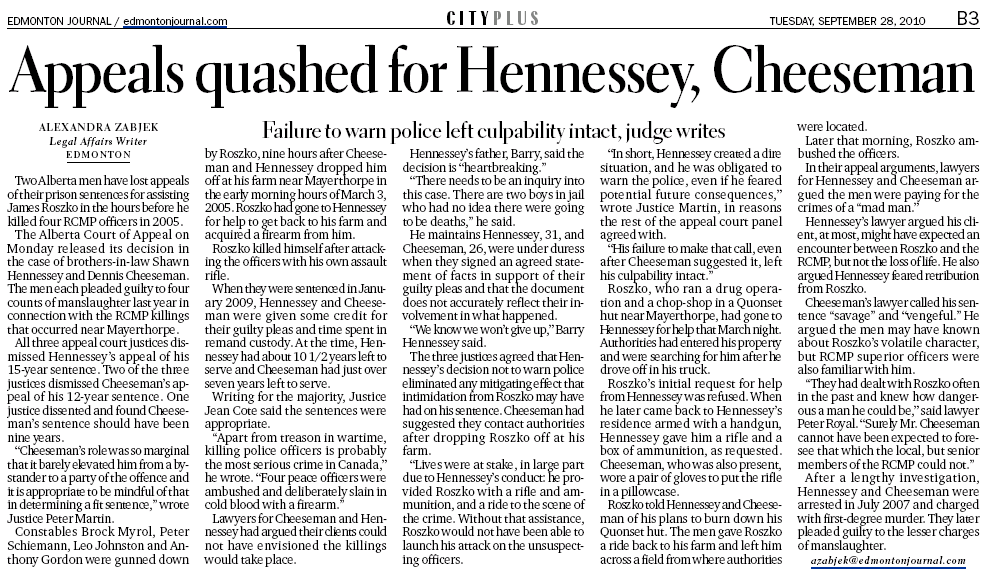
Edmonton Metro's memorial wreath for the slain RCMP Officers
Four junior members of the RCMP were killed in an ambush on 03 March 2005 by a police-hating psychotic who was operating a stolen vehicle chop shop and small marijuana grow-op several miles northeast of Mayerthorpe, AB. The suspect ended his own life even though one member of the Auto Theft Unit, on scene, managed to wound him in the event. Their soft body armour was no match for the H&K .308 assault rifle used in the ambush. Mounties killed instantly by cop-hating Roszko
Murder of four RCMP in Mayerthorpe unpredictable, leaked report suggests
The Canadian Press : The Edmonton Journal
Saturday, March 10, 2007

A leaked federal report into the ambush-murder of four Alberta Mounties has confirmed that the officers died where they stood after being shot multiple times by a man under circumstances that were highly unusual.
"It is unprecedented for someone who is fleeing from police to later return to the location where they are being sought with the intent to murder officers. This is believed to have been the first known occurrence", said the report by a health and safety officer with Human Resources and Skills Development Canada. The four were killed by James Roszko, a man with a lengthy criminal record who was known to harbour a hatred of police.
"Roszko used an assault rifle to fire multiple .308 rounds at the RCMP victims ... . All four RCMP members in the Quonset hut were killed instantly."
When Roszko opened fire in the hut near Mayerthorpe on March 3, 2005, one of the four slain officers, Const. Leo Johnston, was able to fire his gun once before he died. Johnston was an ace shooter who had received perfect marksmanship scores during his police training at RCMP depot in Saskatchewan.
A person familiar with the investigation said Friday Const. Brock Myrol had walked to the back of the building. Constables Johnston and Peter Schiemann were standing together, about 15 metres from the entrance. Const. Anthony Gordon was only metres away from where Roszko hid behind a 1,000-gallon plastic container. But the report, which the federal government has not officially released to the public, does not answer one key question: How did Roszko, last seen driving away from his farm the afternoon before, manage to get back into the hut during the night despite it being guarded by police?
Mounties had sealed the hut while they investigated reports Roszko was running an automobile chop-shop and marijuana grow-operation inside.
"He was very familiar with the natural terrain and structures in the area," said the report. "It is not known how many police resources may have been required to prevent such a covert approach."
By the time he returned to his property, Roszko had acquired firearms, a bedsheet, heavy gloves, heavy socks to cover his boots, a pillow case, binoculars, a water bottle and bear spray.
"Once (the officers) had passed his location, it is believed that he opened fire, ambushing the unsuspecting members."
Outside, two auto theft detectives preparing to enter the hut heard shots and yelling, then encountered Roszko coming out of the hut. He had the semi-automatic across his chest, another rifle slung over his shoulder and a pistol in his belt.
He fired two shots that narrowly missed one detective. One bullet struck a side mirror of a police cruiser and smashed the window. The officer returned fire and Roszko staggered back into the hut. Inside, he killed himself.
The report has made a number of recommendations, including providing police with night-vision goggles, and body armour that can withstand rifle blasts. The report said the officers were trained and well-directed to assess the threat they thought they were facing.
"While Roszko was well-known to police, his behaviour was not consistent with someone who would be considered a deadly threat to the officers," said the report.
The report suggests staffing may have played a part in the tragedy, because even before the murder, Mayerthorpe had to call in help from the nearby Whitecourt detachment to investigate the Roszko case. Also, two of the officers had been working overly long shifts the morning of the murder, and Schiemann wasn't even supposed to be on the scene. He was in plainclothes without body armour or a gun, and had to go to the scene to drop off Myrol when another member was called away.
A criminal investigation into the deaths is still ongoing.
RCMP sting operation over Mountie killings revealed
Involves crime boss, damsel in distress
By JOHN COTTER and TIM COOK, The Canadian Press
Tuesday, January 20, 2009
With four of their fellow officers dead, and convinced that two small-town Alberta men had helped their killer, RCMP set up an elaborate sting operation that included a damsel in distress, a fictitious crime boss and other seedy characters played to the hilt by undercover Mounties.
Their job: Lure one of the suspects into a fake criminal organization and coax him into giving up the goods.
Details of the complex ruse were revealed at a preliminary hearing last May for Shawn Hennessey and Dennis Cheeseman, who were charged with first-degree murder in the deaths of the four officers near Mayerthorpe, Alta., in March 2005.
The details were kept under wraps by court order until Monday when Hennessey, now 29, and Cheeseman, 25, pleaded guilty in an Edmonton courtroom to the lesser charge of manslaughter.
RCMP investigators had launched a two-pronged attack on the brothers-in-law from Barrhead, Alta.
One undercover Mountie posed as a tradesman and attempted to befriend Hennessey by taking him snowmobiling and quadding - two activities Hennessey loved. But the preliminary hearing heard that side of the scheme didn't gain much traction.
The operation to coax Cheeseman into a criminal gang was much more successful.
It began with an undercover female RCMP officer pretending to have car trouble in front of Cheeseman's workplace. The car she was driving had been equipped with a kill switch so the motor would give out at just the right time.
Cheeseman came to help, but the car wouldn't start. He gave the woman a ride to a burger restaurant, where the two exchanged numbers. She offered a story about how she had just broken up with an abusive boyfriend in Calgary.
Their relationship seemed to blossom.
Police needed to get Cheeseman out of the home he shared with Hennessey so that an RCMP team could install listening bugs, so the woman invited Cheeseman to be her date at an office Christmas party.
RCMP organized the fake celebration at an Edmonton hotel with undercover Mounties acting as the woman's co-workers. One Mountie even dressed up as Santa Claus and distributed gifts.
The woman and Cheeseman got so chummy that her colleagues worried the relationship might take a sexual turn. Operation handlers quickly wove in a storyline about how the woman's grandfather had died and she needed to go to Manitoba right away to be with her family.
The woman stayed in touch with Cheeseman, however, and eventually introduced him to another undercover operative, who mentioned he was in a criminal gang. He invited Cheeseman along to steal a mini-loader from someone who owed the gang money.
More missions followed.
Cheeseman was invited to watch "gang members" steal a boat. Then he took part in the sale of stolen cigarettes. The following month, he watched the gang pick up crates of automatic weapons from a plane that had landed at an airport in nearby Edson, Alta.
Cheeseman started seeing some cash for his work - $300 for helping to steal equipment from people who owed the gang money; $700 for helping in the cigarette caper; $500 for helping with the gun shipment.
On each occasion, Cheeseman was told he didn't have to take part in any of the simulated criminal activity. But at the same time he was told that the group operated under a strict code of honesty, loyalty, integrity and trust. Members had to lay it on the line with each other.
"We don't want stories - we want to hear the truth," one officer testified.
Cheeseman stayed in touch with the woman as he was drawn deeper and deeper into the fake criminal front. She asked him to go to Calgary to help move her things from a home she shared with the abusive boyfriend. RCMP used makeup experts to make her appear badly beaten.
Soon the gang's leader started inquiring about Cheeseman's good work. That's when undercover RCMP took the opportunity to subtly turn discussions toward Mayerthorpe.
Gang members told him he had a bright future, but said that if he had any connection to the Mountie shootings, that could draw unwanted heat to the group's operations.
Cheeseman was then lured to Kelowna, B.C., for a meeting with the big crime boss. He was told the gang had links inside a satellite company in the United States that constantly took detailed pictures of the Prairies. Should any photos exist showing Cheeseman driving killer James Roszko back to the farm on the night before the officers were killed, the gang might be able to make the pictures "go away."
On the way back to Barrhead, Cheeseman spilled the beans about Mayerthorpe to a high-level gang member, another RCMP operative. He took the undercover officer on a step-by-step re-enactment of the route he and Hennessey had driven with Roszko the night before the four Mounties were gunned down.
Efforts to befriend Hennessey had gone nowhere. Undercover officers found him suspicious of them. The RCMP partnered a female undercover officer with the tradesman to see if they could get close to Hennessey and his wife as a couple, but with no success.
The Mounties got their break when the fake gang lured both Cheeseman and Hennessey to the airport in Barrhead for another meeting with the crime boss. He had a job with a promise of a big payday in Vancouver.
During the meeting, Hennessey, who was leery of being recorded while talking in vehicles, walked along the runway and spoke with the crime boss. RCMP recorded their conversation with hidden microphones.
After the meeting, another senior gang member stayed in Barrhead with Hennessey. The preliminary inquiry heard that it was at this time that Hennessey finally admitted to driving Roszko to the farm on the night before the officers were murdered.
The Mounties had what they needed.
Within days, Hennessey and Cheeseman were arrested and charged with first-degree murder.

Cheeseman (left) and Hennessey (right)
 The final chapter of this terrible event:
The final chapter of this terrible event:
